The Impact of Google Marketing Live 2023 on Digital Marketing
Google Marketing Live (GML23) is an annual event where Google unveils its latest innovations in marketing technology. It’s an essential platform for digital marketers who strive to stay ahead in the fast-paced, constantly changing landscape of digital marketing.
This year, GML23 didn’t disappoint. GML23 revealed numerous groundbreaking trends, such as predictive analytics and AI integration in marketing strategies. These technological advancements promise to reshape how marketers target, engage, and retain customers.
As a digital marketing agency, observing these developments and understanding their potential to transform digital marketing strategies is essential. We are committed to harnessing the insights from GML23 to deliver cutting-edge solutions to our clients. This blog will explore the new Google Marketing innovations and highlight what you need to know.
Key Highlights from Google Marketing Live 2023
Google Marketing Live is an annual event hosted by Google that brings together marketers, advertisers, and industry professionals worldwide. It is a dynamic platform for marketers to stay ahead of the curve and maximize their online presence in an ever-evolving digital landscape. Let’s look deeper at some topics covered in this year’s event.
- Personalization and Automation: GML23 highlighted the significant role of personalization and automation in today’s marketing strategies. Businesses can now leverage Google’s innovative technology to tailor their messaging to individuals and automate their advertising strategies.
- Privacy and Trust: Similarly, Google emphasized the importance of maintaining consumer privacy and building trust, showcasing new features designed to uphold these principles while enabling effective marketing.
- Enhanced User Experience: A significant focus of GML23 was enhancing user experience. Google showcased various tools and features to enable businesses to create personalized and seamless customer experiences.
- Advertising Innovations: GML23 also introduced a host of advertising innovations. These tools aim to help businesses maximize their reach and engagement while ensuring efficient use of their marketing budget. In the forthcoming months, Google plans to experiment with Search and Shopping ads directly incorporated within AI-driven snapshots and conversational modes.
- Automatically Created Assets: Automatically Created Assets (ACA) will harness the power of generative AI to enhance ad relevance. It achieves this by examining your landing pages and ads and customizing Search ads to align with the context of user search inquiries.
As we look toward the future, the dynamic and rapidly evolving marketing landscape is poised to undergo transformative changes.
The Future of Marketing As Defined by GML23
GML23 unveiled a glimpse into the future of marketing, showcasing exciting advancements and trends that will shape the industry. With a focus on emerging technologies such as artificial intelligence, virtual reality, and voice search, GML23 emphasized the importance of personalized and immersive consumer experiences. Let’s look at two main focuses for the year to come.
- Predictive Analytics in Marketing: Predictive analytics uses data, statistical algorithms, and machine learning techniques to identify future outcomes based on historical data. The future of marketing lies in its ability to predict customer behavior, personalizing content to their unique needs and preferences.
- Machine Learning and AI: Machine learning and AI technologies have significantly impacted the marketing scene, providing unprecedented insights into customer behavior and enhancing the ability to deliver highly-targeted campaigns. GML23 only confirmed the growing importance of these technologies in the marketing landscape.
Amidst the ever-changing marketing landscape, it’s important to note that having a hybrid model can help bridge the gap between new digital marketing and traditional digital marketing.
The Hybrid Model
We know that a mix of AI innovation and human digital marketers will shape the future of digital marketing. Onimod Global is taking the insights from GML23 to a new level. Our agency is integrating personalization and automation into its marketing strategies, enabling businesses to reach their target audience with precision and effectiveness.
Onimod Global is committed to building trust and compliance in all our marketing efforts. We are adjusting our practices to align with Google’s new guidelines, ensuring their clients’ campaigns are effective and ethical. Investing in AI systems means relying on them only partially.
Stay up to Date: We are Google Partners
To make sure you’re keeping up to date with the latest Google updates and trends, Onimod Global is a trusted Google Partner. Advertising agencies that are members of the Google Partners program like us at Onimod Global contain certified employees and are companies trusted by Google.
Last Thoughts
The future of digital marketing is brimming with excitement and endless possibilities, as evidenced by the insights gained from events like Google Marketing Live 2023. This event provides businesses with valuable knowledge on leveraging the latest technologies and trends to drive their success.
However, with the rapidly evolving nature of digital marketing, navigating these technologies and staying ahead can be daunting without the right partner. Enter Onimod Global, a leading digital marketing agency and Google Partner dedicated to remaining at the forefront of industry trends. With our commitment, we can empower businesses to harness the power of digital marketing and achieve their goals effectively.
Contact us to learn more about how we can help with your social media strategy today.


